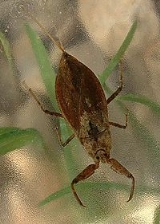
Nepidae
Encyclopedia
Nepidae is a family of insect
s in the order Hemiptera
, suborder Heteroptera
.http://tolweb.org/tree?group=Nepomorpha They are commonly called waterscorpions for their superficial resemblance to a scorpion
, which is due to the raptorial forelegs and the presence of a long slender process at the posterior end of the abdomen, simulating a tail. There are 14 genera in the family, in two subfamilies, Nepinae and Ranatrinae. Members of the genus Ranatra are sometimes called needle bugs or water stick insects as they are more slender than Nepa
and feed primarily on invertebrates, but occasionally take small fish or tadpoles. Respiration in the adult is effected by means of the caudal process, which consists of a pair of half-tubes capable of being locked together to form a siphon by which air is conducted to the trachea
e at the apex of the abdomen when the tip of the tube is thrust above the surface of the water. In immature forms the siphon is undeveloped and breathing takes place through six pairs of abdominal spiracles. The eggs, which are laid above the waterline in mud, decomposing vegetation, the stems of plants or rotting wood, are supplied with air by filamentous processes which vary in number among the genera. They live in the North Shore of Mass.
In Nepa the body is broad and flat; but in an allied water-bug, Ranatra, which contains a single British species (R. linearis), it is long and narrow, while the legs are very slender and elongated.
Insect
Insects are a class of living creatures within the arthropods that have a chitinous exoskeleton, a three-part body , three pairs of jointed legs, compound eyes, and two antennae...
s in the order Hemiptera
Hemiptera
Hemiptera is an order of insects most often known as the true bugs , comprising around 50,000–80,000 species of cicadas, aphids, planthoppers, leafhoppers, shield bugs, and others...
, suborder Heteroptera
Heteroptera
Heteroptera is a group of about 40,000 species of insects in the Hemiptera. Sometimes called "true bugs", that name more commonly refers to Hemiptera as a whole, and "typical bugs" might be used as a more unequivocal alternative since among the Hemiptera the heteropterans are most consistently and...
.http://tolweb.org/tree?group=Nepomorpha They are commonly called waterscorpions for their superficial resemblance to a scorpion
Scorpion
Scorpions are predatory arthropod animals of the order Scorpiones within the class Arachnida. They have eight legs and are easily recognized by the pair of grasping claws and the narrow, segmented tail, often carried in a characteristic forward curve over the back, ending with a venomous stinger...
, which is due to the raptorial forelegs and the presence of a long slender process at the posterior end of the abdomen, simulating a tail. There are 14 genera in the family, in two subfamilies, Nepinae and Ranatrinae. Members of the genus Ranatra are sometimes called needle bugs or water stick insects as they are more slender than Nepa
Nepa (genus)
Nepa is a genus belonging to the family Nepidae, known as water scorpions....
and feed primarily on invertebrates, but occasionally take small fish or tadpoles. Respiration in the adult is effected by means of the caudal process, which consists of a pair of half-tubes capable of being locked together to form a siphon by which air is conducted to the trachea
Invertebrate trachea
The invertebrate trachea refers to the open respiratory system composed of spiracles, tracheae, and tracheoles that terrestrial arthropods have to transport metabolic gases to and from tissues....
e at the apex of the abdomen when the tip of the tube is thrust above the surface of the water. In immature forms the siphon is undeveloped and breathing takes place through six pairs of abdominal spiracles. The eggs, which are laid above the waterline in mud, decomposing vegetation, the stems of plants or rotting wood, are supplied with air by filamentous processes which vary in number among the genera. They live in the North Shore of Mass.
In Nepa the body is broad and flat; but in an allied water-bug, Ranatra, which contains a single British species (R. linearis), it is long and narrow, while the legs are very slender and elongated.
External links
- http://www.bugsurvey.nsw.gov.au/html/popups/bpedia_18_tol_wa-sc.html
- http://www.dnr.state.wi.us/org/caer/ce/eek/critter/watercritter/scorpion.htm
- http://eny3005.ifas.ufl.edu/lab1/Hemiptera/Nepid.htm
- http://delta-intkey.com/britin/hem/www/nepidae.htm

